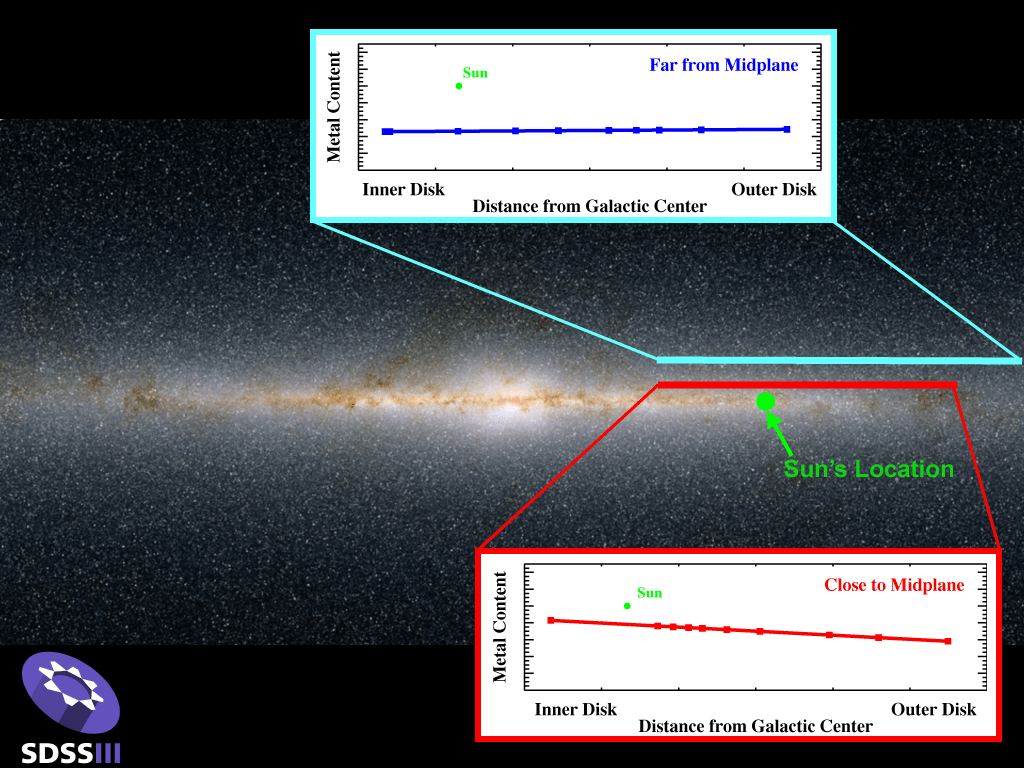[/caption]Like a worldly backpacker, many stars in the Milky Way Galaxy have made interesting journeys, and have interesting stories to tell about their past. For over a decade, the Sloan Digital Sky Survey (SDSS) has been mapping stars in our Galaxy.
This week at the American Astronomical Society meeting in Austin, Texas, astronomers from University of California – Santa Cruz presented new evidence that claims to answer many questions about stars located in the disk of our galaxy. The team’s results are based on data from the Sloan Extension for Galactic Understanding and Exploration 2 (SEGUE-2).
The SEGUE-2 data is comprised of the motions and chemical compositions of over 118,000 stars, most of which are in the disk of our galaxy, but a few stars in the survey take the “scenic” route in their orbit.
“Some disk stars have orbits that take them far above and below the plane of the Milky Way,” said Connie Rockosi (University of California – Santa Cruz), “We want to understand what kinds of stars those are, where they came from, and how they got there.”
Aside from the orbital paths of these “wandering” stars being different from most other Milky Way stars, their chemical composition also makes them unique. A team led by Judy Cheng (University of California – Santa Cruz) studied the metallicity of stars at different locations in the galaxy. By studying the metallicity, Cheng and her team were able to examine how the disk of the Milky Way disk grew over time. Cheng’s study also showed that stars closer to the center of the galaxy have higher metallicity than those farther from the galactic center. “That tells us that the outer disk of our Galaxy has formed fewer generations of stars than the inner disk, meaning that the Milky Way disk grew from the inside out,” added Cheng.
When Cheng studied the “wandering” stars, she found their metallicity doesn’t follow the same trend – no matter where she looked in the target area of the Galaxy, stars had low metal content. “The fact that the metal content of those stars is the same everywhere is a new piece of evidence that can help us figure out how they got to be so far away from the plane,” Rockosi mentioned.
What the team has yet to determine is if the stars formed with their “wandering” orbits, or if something in the past caused them to migrate to their unique paths. “If these stars were born with these orbits, they were born at the same rate all over the galaxy,” Cheng said. “If they were born with regular orbits, then whatever happened to them must have been very efficient at mixing them up and erasing any patterns in the metal content, such as the inside-out trend we see in the plane.”
Some possible reasons for this mixing include past mergers of our Galaxy and others, or possibly spiral arms sweeping through the disk. Cheng’s observations will help determine what causes stars to wander far from their birthplace. Other galaxies have shown stars in their disks as well, so solving the puzzle presented by these stars will help researchers better understand how spiral galaxies like the Milky Way form.
If you’d like to read Cheng and Rockosi’s paper “Metallicity Gradients In The Milky Way Disk As Observed By The SEGUE Survey”, you can download a copy at: http://www.ucolick.org/~jyc/gradient/cheng_apj_fullres.pdf
Source: UC Santa Cruz press release


Interesting content sharing
http://www.simplyrichhome.com
Regards
Richard
108 Easy Ways To Make Money | Secrets On How To Make Money Guide
$1,868,988.67 + $188,383.87 Deposited In Your Bank Account Life Can Turn 360 degrees for you
http://www.simplyrichhome.com